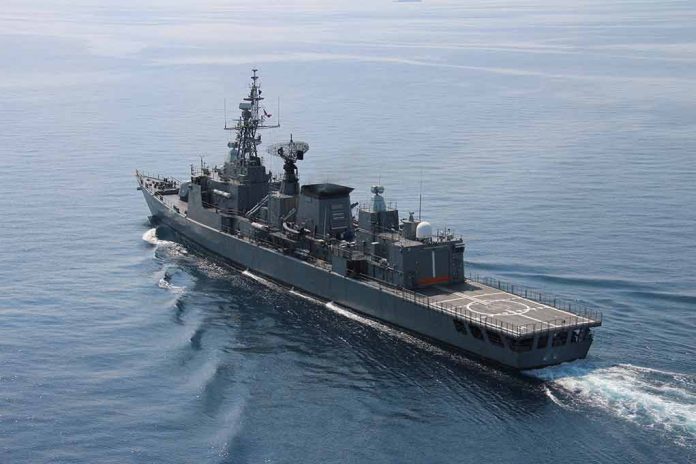
Kim Jong-un detained and publicly humiliated four shipyard officials after North Korea’s newest destroyer dramatically capsized during its launch ceremony, revealing the brutal consequences of failure in the secretive regime’s military industrial complex.
Key Takeaways
- North Korea’s second naval destroyer toppled during launch at Chongjin Shipyard, leading to the detention of four officials for “criminal negligence”
- Kim Jong-un publicly criticized military officials, scientists, and shipyard operators—a rare admission of failure in North Korean state media
- Satellite imagery revealed the vessel on its side and partially submerged, contradicting regime claims of “minor damage”
- The failed launch represents a significant setback to Kim’s naval modernization efforts aimed at countering perceived US threats
- Despite the embarrassment, North Korea continues to press forward with military development to maintain its status as a nuclear power
High-Profile Naval Disaster
In a rare public admission of failure, North Korean state media reported that three shipyard officials and a military representative were detained following the catastrophic launch of the regime’s second-ever destroyer. The vessel dramatically tipped onto its side during what should have been a celebratory launch ceremony at the Chongjin Shipyard. Kim Jong-un personally condemned those responsible in unusually harsh terms, describing the incident as a “criminal act caused by absolute carelessness, irresponsibility and unscientific empiricism,” according to North Korean state media reports.
The detained officials include the shipyard’s chief engineer, head of hull construction, and deputy manager, along with a military representative overseeing the project. Such public acknowledgment of failure, coupled with swift punishment, underscores the strategic importance Kim places on naval modernization in his military planning. While North Korea claimed the damage was minor and repairs would take only 10 days, satellite imagery analyzed by independent experts showed the vessel partially submerged with significant damage, suggesting a much longer recovery timeline.
Regime’s Harsh Response
North Korea’s Central Military Commission, one of the country’s most powerful military bodies, backed Kim’s position, declaring that those responsible “can never evade their responsibility for the crime.” This statement reflects the regime’s typical approach to failure—finding scapegoats rather than addressing systemic issues. The harsh response indicates the destroyer was a high-priority project in Kim’s military modernization program, which has accelerated in recent years despite international sanctions and economic challenges.
“criminal act caused by absolute carelessness, irresponsibility and unscientific empiricism,” said Kim Jong Un, Supreme Leader of North Korea
Technical analyses suggest the failure occurred when a transport cradle detached during the launch procedure, causing the vessel to list dramatically and then capsize. Satellite imagery later showed the destroyer on its side with its deck partially submerged, covered by blue tarps in an apparent attempt to conceal the extent of the damage from aerial observation. The incident represents a significant setback for North Korea’s naval capabilities, which have historically lagged behind its missile and nuclear programs.
Strategic Implications
This failed destroyer launch highlights the significant challenges North Korea faces in its quest to develop advanced military capabilities under international sanctions. While the regime has made remarkable progress in missile technology and nuclear weapons, shipbuilding requires industrial capacity, materials, and expertise that are particularly difficult to develop in isolation. The destroyer would have represented a significant upgrade to North Korea’s aging naval fleet, which consists primarily of smaller patrol boats and submarines rather than major surface combatants.
“can never evade their responsibility for the crime.” according to North Korea’s powerful Central Military Commission
Despite this embarrassment, Kim Jong-un appears determined to continue his military modernization campaign. The swift punishment of officials serves both to deflect blame from his leadership and to send a message about the consequences of failure in critical military projects. For American interests in the region, the incident provides valuable intelligence about North Korea’s naval capabilities and limitations while demonstrating that sanctions continue to hamper the regime’s military development efforts, even as Kim Jong-un remains determined to position his country as a nuclear-armed military power capable of deterring American influence.



